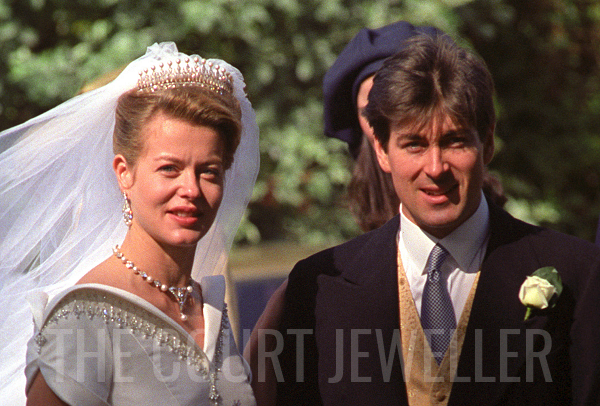 |
| Photo licensed to The Court Jeweller. DO NOT REPRODUCE. |
Jewel History: Exquisitely Simple Detail in Princess’s Wedding Dress (1960)
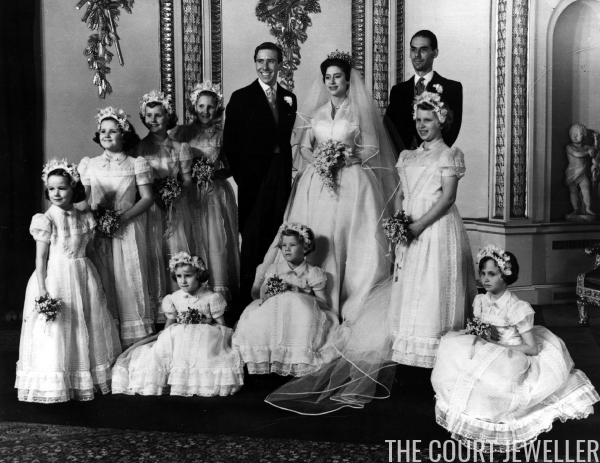 |
| Antony Armstrong-Jones, Princess Margaret, and their wedding party, including Princess Anne and Dr. Roger Gilliatt, pose for an official wedding portrait at Buckingham Palace, May 1960 (Getty Images) |
Princess Margaret [1] was an all-white bride today in a beautiful dress of white silk organza and carrying a bouquet of white orchids.
The dress she wore for her marriage to Antony Armstrong-Jones [2] probably was the simplest royal wedding gown ever in terms of embroidery and other trimmings. Its only trimming was rouleau piping in the same white silk organza from which the whole dress is made. This time royal dressmaker Norman Hartnell [3] added no pearls, no rhinestones, no sequins.
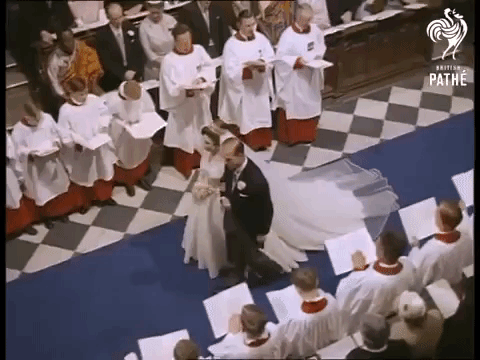
The dress was classic in style, with a fitted hip-length bodice slightly pointed in front and a voluminous skirt flowing out into a train at the back. The high standup neckline with a small V-front was piped with an organza rouleau which continued right down the centre front of the bodice.
The skirt was made of three layers of organza cut into 12 panels set in unpressed pleats into the base of the bodice and joined by a fine rouleau piping which gave the effect of a stripe. The entire hem of the dress, the end of the tight-fitting, full-length sleeves and the fine veil also were piped with organza rouleau. The whole dress was mounted on a foundation of stiffened white tulle.
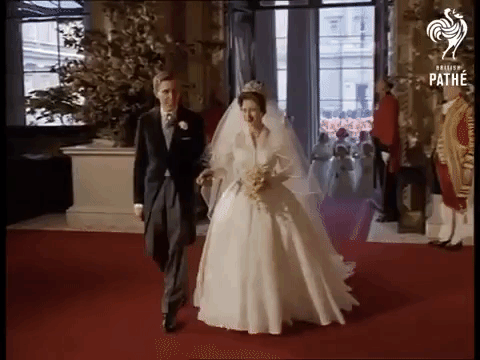
With it the tiny princess wore white crepe court shoes with white satin facings and 2 1/2-inch heels.
Princess Anne [4] and the seven other bridesmaids [5] wore dresses which were replicas of the bride’s first evening dress — the favorite of Margaret’s father, the late King George VI [6].
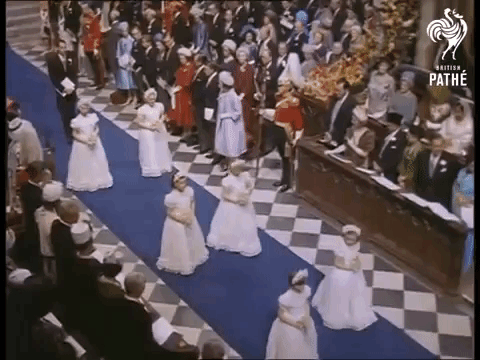
The dresses were of plain white silk organza, like the bride’s, had little-girl bodices, short cuffed sleeves and peter pan collars, tied with a blue ribbon bow. Panels of broderie anglaise, slotted with pale blue ribbons, fell from the narrow waist to the ground-length skirt. Around the hem was a band of graduated pin-tucking, bordered with three rows of broderie anglaise.
The bridesmaids’ headdress was in the form of a halo, slightly higher in the centre and with a forward sweep over the ear and on to the cheek, in soft white feathers. They were made up of flowers, fashioned in white feathers, interspersed with white ribbon rosettes and groups of “trembling” crystal drops.
The bridesmaids’ shoes were soft white kid court shoes with low kid-covered heels and white satin bows.
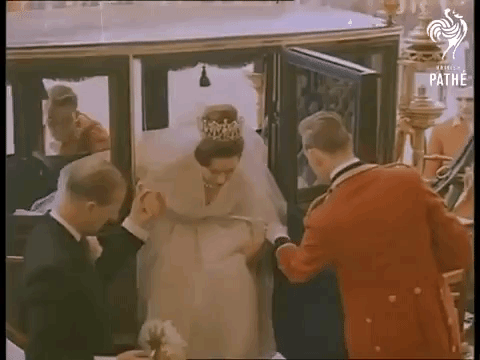
In the midst of royal splendor, only a wide diamond tiara [7] blazing on her head distinguished Princess Margaret’s bridal attire from that of other springtime brides.
The royal wedding dress was no surprise, for it closely resembled advance reports and sketches. But Margaret’s hair-do was. A high chignon was pinned on top of her own short hair, adding inches to her five feet two inches. A veil of white illusion tulle sprang out on each side above the ears. It pulled back from the shoulders and fell to the floor.
Margaret’s wedding bouquet was small and dainty, slightly crescent-shaped, of cymbidium orchids — white with a slight pink flush on the petals, lilies of the valley and stephanotis, with a few off-white odontoglossum orchids.
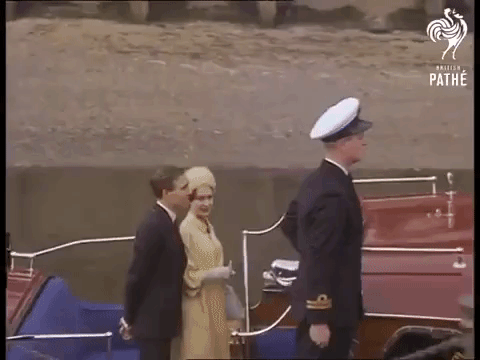
Margaret’s going-away dress was of pale yellow silk chiffon, with the bodice cut on the bias and gently draped to a high neckline. Soft sleeves just covered the shoulders. The slim skirt was elaborately draped from low left to waist-high right. Two layers of the fine chiffon were used throughout.
The coat over the dress was of pure silk shantung, also in sunshine yellow. It was straight and loose, cut high at the neck and with a small upstanding collar set away from the neck. Inverted pleats on either side of the back of the coat gave a little bulk across the shoulder blades. The coat had three-quarter-length sleeves.
The Princess’s hat was a tiered toque in pale yellow veiling, dotted with minute lover’s knots in yellow chenille. Her shoes were of pale grey nylon mesh with a 2 1/2-inch heel of matching calf.
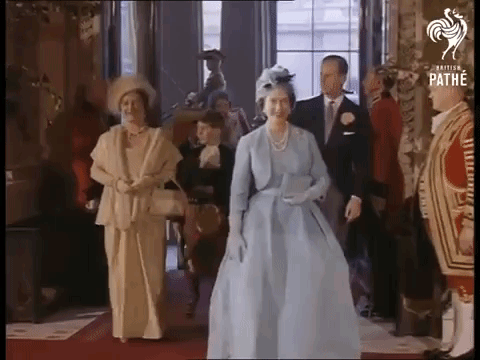
The Queen [8], who was pretty much of a bystander today, wore a turquoise-blue lace gown with a bustle. She also wore pearls, a three-strand necklace and big pearl earrings.
The Queen Mother [9] was attired in a long, slim white sheath of white and gold lame, with matching mink-trimmed sheath. Her jewels were diamonds — big, dangling earrings and a sparkling medallion necklace.
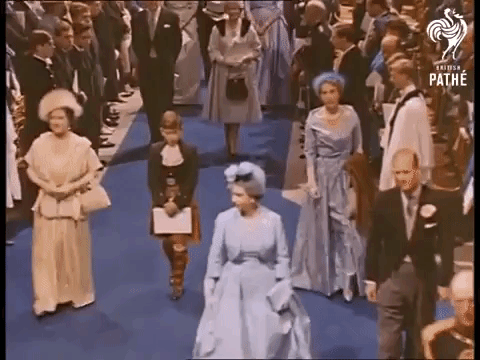
The groom’s mother, the Countess of Rosse [10] — his parents are divorced — was in a huge boule hat and a fur-collared coat. A multi-strand pearl necklace filled her deep rounded neckline with a large jewelled clip in the centre.
The only visiting royalty [11], Queen Ingrid of Denmark [12], chose a deep v-shaped decollete floral dress with a thick pearl necklace. Diamonds glistened in her small flowered hat and at her ears and shoulder.
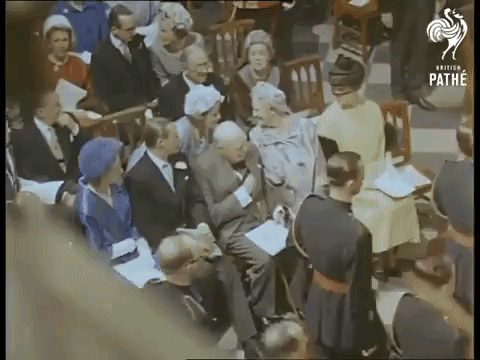
Lady Churchill [13] chose a small halo hat with a full pastel coat. Sir Winston [14] wore a fine old frock coat that [has] seen quite a bit of history in its time. The bridegroom, seldom out of his slacks and sweater a few months ago, wore frock coat and striped pants. His flourish for the occasion was a white carnation. On the male side, Prime Minister Macmillan [15] let a large white handkerchief drop languidly from his breast pocket. He wore a striped tie — unusual with a tailcoat.
NOTES
1. Princess Margaret of the United Kingdom (1930-2002), younger sister of Queen Elizabeth II, married Antony Armstrong-Jones at Westminster Abbey on May 6, 1960. The couple had two children, David and Sarah, before divorcing in 1978.
2. Antony Armstrong-Jones (1930-2017), an artist and society photographer, married Princess Margaret, younger sister of Queen Elizabeth II, at Westminster Abbey on May 6, 1960. The Queen created him 1st Earl of Snowdon in 1961, just before the birth of the couple’s first child, David. After his 1978 divorce from Princess Margaret, Snowdon married Lucy Lindsay-Hogg and had another daughter, Frances. He also had two other children, Polly Fry and Jasper Cable-Alexander.
3. Norman Hartnell (1901-1979) was a British fashion designer who was best known for making clothes for various members of the British royal family. He designed the wedding dresses of Princess Alice, Duchess of Gloucester (1935), Queen Elizabeth II (1947), and Princess Margaret (1960). In 1953, he received his greatest royal commission of all, making Queen Elizabeth II’s Coronation Dress.
4. Princess Anne of the United Kingdom (born 1950), Princess Margaret’s nine-year-old niece, served as her aunt’s chief bridesmaid.
5. Princess Margaret’s other bridesmaids were Marilyn Wills (Margaret’s goddaughter and cousin, daughter of Jean Elphinstone Wills), Annabel Rhodes (Margaret’s cousin, daughter of Margaret Elphinstone Rhodes), Catherine Vesey (the groom’s niece), Lady Virginia Fitzroy, Lady Rose Nevill, Lady Angela Nevill, and Sarah Lowther (daughter of Margaret’s lady-in-waiting).
6. King George VI of the United Kingdom (1895-1952), the bride’s father, died in 1952, nearly a decade before this royal wedding.
7. Princess Margaret wore the Poltimore Tiara on her wedding day; you can read our article about it over here.
8. Queen Elizabeth II of the United Kingdom (born 1926) was the bride’s elder sister. In May 1960, she had recently given birth to her third child, Prince Andrew.
9. Queen Elizabeth the Queen Mother (1900-2002), the widow of King George VI, was the mother of the bride at this royal wedding.
10. Anne Parsons, Countess of Rosse (1902-1992) was the mother of the groom, Antony Armstrong-Jones. His father was her first husband, Ronald Armstrong-Jones. In 1935, following her divorce from Ronald, Anne married the 6th Earl of Rosse. The current Earl of Rosse, Brendan Parsons, is her son.
11. Because only one foreign royal, Queen Ingrid, attended the wedding, the press was up in arms over a possible snub of Margaret’s wedding.
The Associated Press reported, “Some British royal newspapers say European royalty is boycotting Princess Margaret’s wedding, and the papers don’t like it. The Daily Herald said so far Queen Ingrid of Denmark had sent the only royal acceptance. The Danish court said King Frederik IX had another engagement that conflicted with the May 6 ceremony. ‘I come regretfully to the conclusion that the royal houses of Europe are boycotting Princess Margaret for reasons other than mere inconvenience, prior engagements or even protocol,’ said Herald columnist Henry Fielding.
“Irked at rumors that Scandinavia’s royalty were not going to the wedding because Margaret’s fiance, Antony Armstrong-Jones, is a commoner, the London Daily Express thundered, ‘The haughtiness of the Scandinavians merely rouses laughter. If they do not come to the wedding, they will not be missed.’
“A spokesman for Norway’s royal family called any suggestion of a boycott ‘sheer nonsense.’ King Olav’s daughter, Princess Ragnhild, is happily married to a commoner — a Norwegian ship owner.”
Other newspapers noted that the British royals had perhaps made their own bed on the issue. The UPI noted that the “record shows that since the war the British royal family has been one of the major users of the ‘other engagement’ excuse when it comes to turning down royal weddings. In that period it has failed to show up at six of the 10 to which it was invited,” adding, “Perhaps the most flagrant example of Windsor snubbing, however, was the failure of either Prince Philip or the Queen to attend the funeral of Norway’s King Haakon in 1957. The Queen’s uncle, the Duke of Gloucester, was sent instead.”
Interestingly, Margaret and Tony became the Windsors’ go-to representatives at foreign royal weddings immediately after their own wedding. The couple attended the wedding of King Baudouin of the Belgians in 1960, and Margaret represented the Queen at the wedding of Princess Astrid of Norway in 1961. (Marlene Koenig keeps a list of British royal representatives for major foreign royal events.)
12. Queen Ingrid of Denmark (1910-2000), born Princess Ingrid of Sweden, was closely related to the British royal family. Her mother, Princess Margaret of Connaught, was a British princess (and a granddaughter of Queen Victoria and Prince Albert). Ingrid was also one of Princess Margaret’s godparents.
13. Clementine Spencer-Churchill, Lady Churchill (1885-1977) was the wife of Sir Winston Churchill, one of the most prominent British leaders of the 20th century. In 1965, she received a life peerage of her own, becoming Baroness Spencer-Churchill.
14. Sir Winston Churchill (1874-1965) was one of the most important British politicians and statesmen of the 20th century, twice serving as the country’s prime minister. In 1960, he was retired and increasingly ill after suffering a series of strokes. He died five years later.
15. Harold Macmillan (1894-1986) was the British prime minister at the time of the wedding.
The Daily Diadem: The York Diamond Tiara
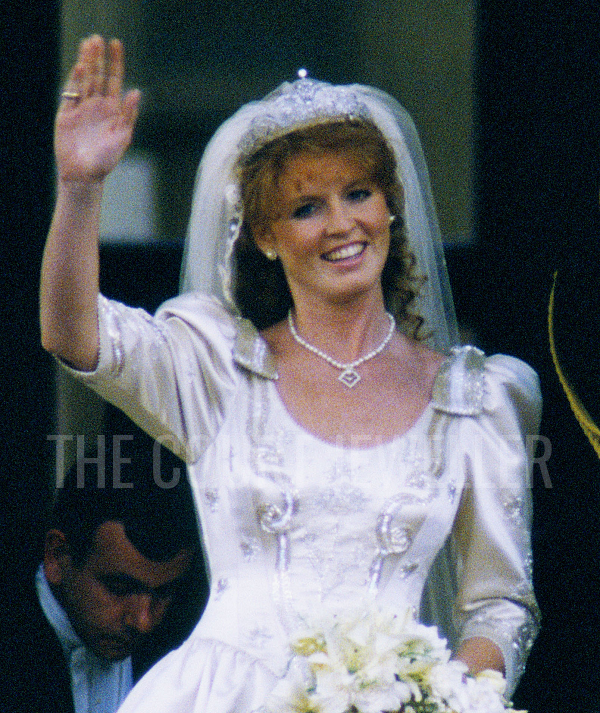 |
| Photo licensed to The Court Jeweller. DO NOT REPRODUCE. |
- « Previous Page
- 1
- …
- 58
- 59
- 60
- 61
- 62
- …
- 126
- Next Page »